目录
关于cifar数据集网上已经有很多使用的教程,matlab官方也给出了一个示例,但是因为课程要求我们不能使用网上的示例,并且要自己分析网络结构对于训练结果的影响,所以我写了这篇文章,记录一下自己摸索着使用cifar-10数据集的过程。
下载cifar-10数据集
点击下面这个链接,找到下图里蓝色字样的下载链接就可以下载cifar-10的数据集啦。按照需求下载即可,我需要在matlab里处理这些数据,因此下载的是matlab version。
cifar-10 and cifar-100 datasets (toronto.edu)
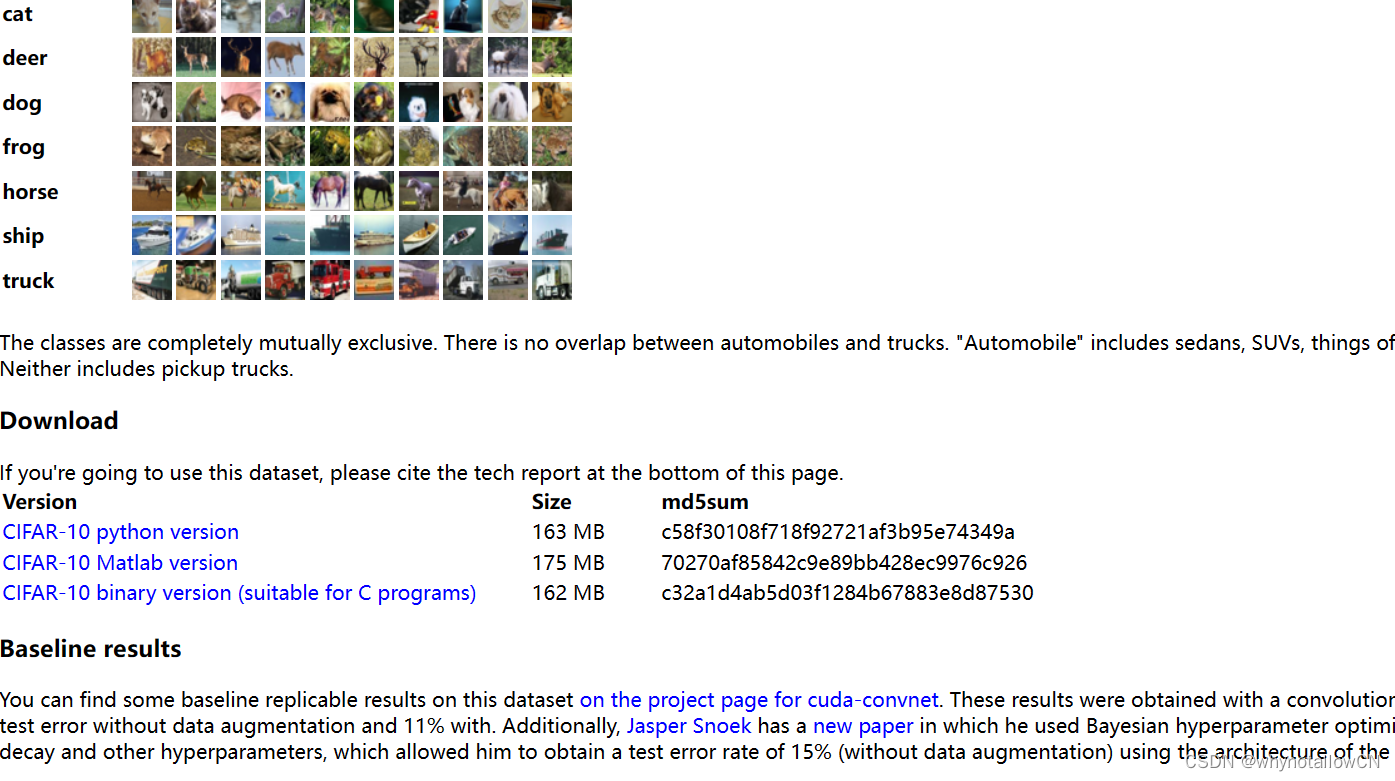
对数据集进行处理
由于我的训练网络是在matlab提供的示例基础上进行修改得来的,而该网络读取的是.jpg或,png格式的文件,但cifar-10提供的是.mat格式的文件,因此需要先对解压后的cifar-10文件进行处理。
首先在matlab的根目录下创建名为“cifar-10-batches-mat”的文件夹,并在该文件夹下创建名为“test”和“train”的文件夹,在“test”和“train”文件夹里分别创建名为“0”-“9”的文件夹。等会我们要把数据集里的图片存到这里,训练集的十类数据按类放进“train”文件夹下的“0”-“9”的文件夹里,同样,测试集的十类数据放进“test”文件夹下的“0”-“9”的文件夹里。(选择其他位置也可以,只是放在matlab根目录下调用起来比较方便)
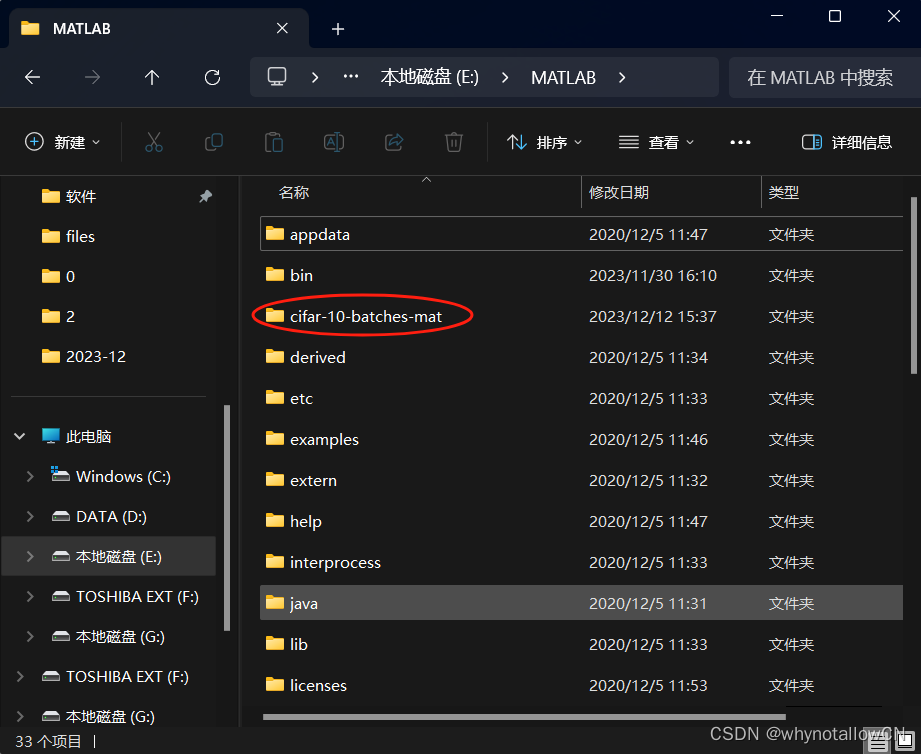
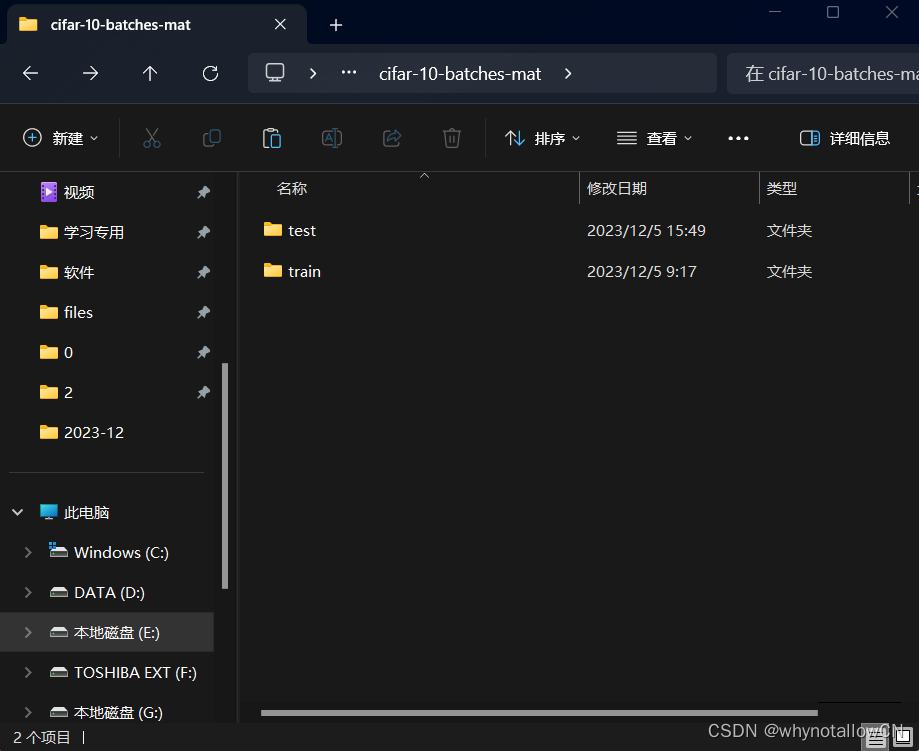
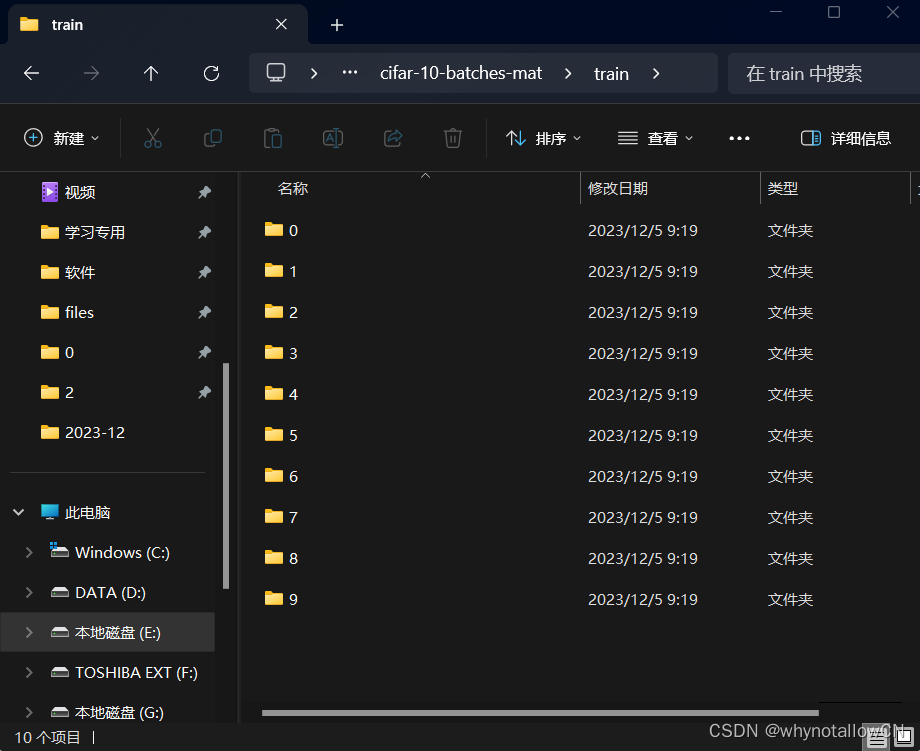
之后就可以使用matlab把数据集里的图片按标签放在这些文件夹里啦,具体的代码如下:
%% 从test_batch中提取图片的代码
load(['e:\matlab\cifar-10-batches-mat\test_batch.mat'])%这里的路径需要换成自己的.mat文件的路径
for i=1:size(data,1)
p=data(i,:);
label=labels(i);
fig=zeros(32,32,3);
fig(:,:,1)=reshape(p(1:1024),32,32)';
fig(:,:,2)=reshape(p(1025:2048),32,32)';
fig(:,:,3)=reshape(p(2049:end),32,32)';
imwrite(fig/256,['e:\matlab\cifar-10-batches-mat\test\',num2str(label), '\_label_' num2str(label) '_' num2str(i) ,'.png'])%这里的路径换成你需要保存的路径
end%% 从data batch 1-5中提取图片的代码
for j =1:5
load(['e:\matlab\cifar-10-batches-mat\data_batch_',num2str(j),'.mat'])%这里改成data_batch所在的路径
for i=1:size(data,1)
p=data(i,:);
label=labels(i);
fig=zeros(32,32,3);
fig(:,:,1)=reshape(p(1:1024),32,32)';
fig(:,:,2)=reshape(p(1025:2048),32,32)';
fig(:,:,3)=reshape(p(2049:end),32,32)';
imwrite(fig/256,['e:\matlab\cifar-10-batches-mat\train\',num2str(label), '\_label_' ,num2str(label) ,'_', num2str(j),'_', num2str(i) ,'.png'])%这里改成想要保存的路径
end
end如果将数据集解压到matlab根目录下,并按照上文的要求在matlab根目录下创建了文件夹,那么代码中注释的部分就只需要修改前面matlab的路径即可。
执行完代码后你会发现,“test”和“train”的每个子文件夹下图片都已经按照它的类别分好了。比如“0”文件夹,其中就只包含标签为“airplane”的图片。
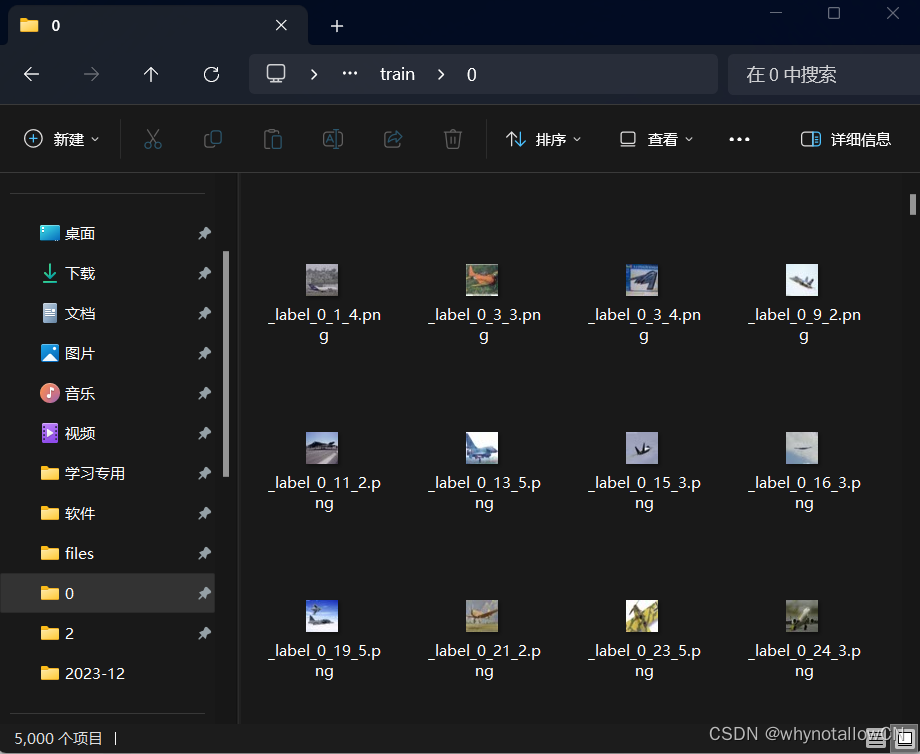
设计网络结构
基础识别网络的设计
首先向matlab中导入这些图片和对应的标签,代码如下:
digitdatasetpath = fullfile(matlabroot,'cifar-10-batches-mat','train');
imds = imagedatastore(digitdatasetpath, ...
'includesubfolders',true,'labelsource','foldernames');
ytrain=imds.labels;
digittestdatasetpath = fullfile(matlabroot,'cifar-10-batches-mat','test');
test_imds = imagedatastore(digitdatasetpath, ...
'includesubfolders',true,'labelsource','foldernames');其中“matlabroot”变量代表matlab的根目录位置。
之后设置网络输入参数,因为cifar数据集提供的是 的rgb图片,因此设置图片输入层参数为32 32 3。同时为了防止网络对图片的过拟合,需要对图片进行强化,具体来说就是对图片设置随机反转、随机x轴或y轴平移等。代码如下:
的rgb图片,因此设置图片输入层参数为32 32 3。同时为了防止网络对图片的过拟合,需要对图片进行强化,具体来说就是对图片设置随机反转、随机x轴或y轴平移等。代码如下:
imagesize = [32 32 3];
pixelrange = [-4 4];
imageaugmenter = imagedataaugmenter( ...
'randxreflection',true, ...
'randxtranslation',pixelrange, ...
'randytranslation',pixelrange);
augimdstrain = augmentedimagedatastore(imagesize,xtrain,ytrain, ...
'dataaugmentation',imageaugmenter, ...
'outputsizemode','randcrop');网络的设置了三层卷积层,相邻卷积层之间通过池化层连接,最后连接一个全连接层。这样一个简单的网络就设计好啦。训练轮次maxepochs设置为20轮,验证集validationdata设置为刚导入的测试集图片“test_imds”,验证频率validationfrequency设置为30,即可开始训练。完整代码如下
%% 导入训练集数据和验证集数据
digitdatasetpath = fullfile(matlabroot,'cifar-10-batches-mat','train');
imds = imagedatastore(digitdatasetpath, ...
'includesubfolders',true,'labelsource','foldernames');
ytrain=imds.labels;
digittestdatasetpath = fullfile(matlabroot,'cifar-10-batches-mat','test');
test_imds = imagedatastore(digitdatasetpath, ...
'includesubfolders',true,'labelsource','foldernames');
% figure;
% perm = randperm(10000,20);
% fprint("b7744f63db749e48c05c06f7f3bd11d4")
% for i = 1:20
% subplot(4,5,i);
% imshow(imds.files{perm(i)});
% end
labelcount = counteachlabel(imds)
img = readimage(imds,1);
for i =1:50000
xtrain(:,:,:,i)=readimage(imds,i);
end
size(img)
%% 设置训练参数
imagesize = [32 32 3];
pixelrange = [-4 4];
imageaugmenter = imagedataaugmenter( ...
'randxreflection',true, ...
'randxtranslation',pixelrange, ...
'randytranslation',pixelrange);
augimdstrain = augmentedimagedatastore(imagesize,xtrain,ytrain, ...
'dataaugmentation',imageaugmenter, ...
'outputsizemode','randcrop');
%% 设置网络结构
layers = [
imageinputlayer([32 32 3])
convolution2dlayer(5,16,'padding','same')
batchnormalizationlayer
relulayer
maxpooling2dlayer(2,'stride',2)
convolution2dlayer(5,32,'padding','same')
batchnormalizationlayer
relulayer
maxpooling2dlayer(2,'stride',2)
convolution2dlayer(5,64,'padding','same')
batchnormalizationlayer
relulayer
fullyconnectedlayer(10)
softmaxlayer
classificationlayer];
%% 设置训练选项
options = trainingoptions('sgdm', ...
'initiallearnrate',0.01, ...
'maxepochs',20, ...
'shuffle','every-epoch', ...
'validationdata',test_imds, ...
'validationfrequency',30, ...
'verbose',false, ...
'plots','training-progress','executionenvironment','gpu');
net = trainnetwork(augimdstrain,layers,options);
%% 对有效识别图片进行分类并计算准确率
ypred = classify(net,test_imds);
yvalidation = test_imds.labels;
accuracy = sum(ypred == yvalidation)/numel(yvalidation)把上面的代码粘到matlab里直接运行即可。训练时间大概为30min(因硬件不同而异),训练之后就可以得到一个能够识别这十类图片的网络了。
基础网络的训练结果和改进
根据上文的代码,即可训练出一个网络。但是我训练完这个网络之后发现一个问题,那就是该网络对“猫”和“狗”的识别效果很差。
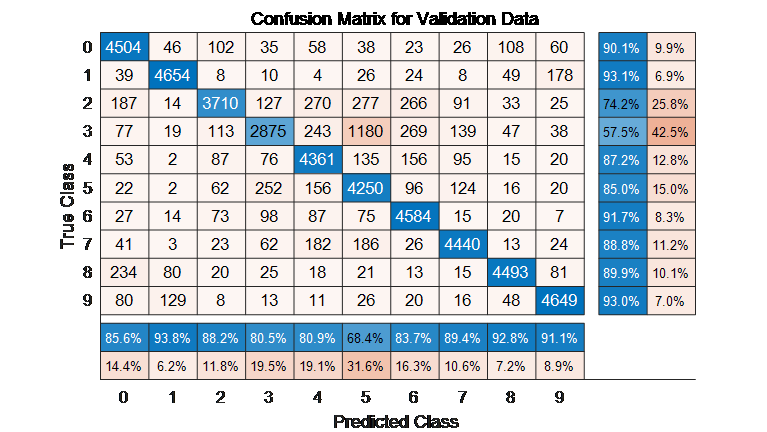
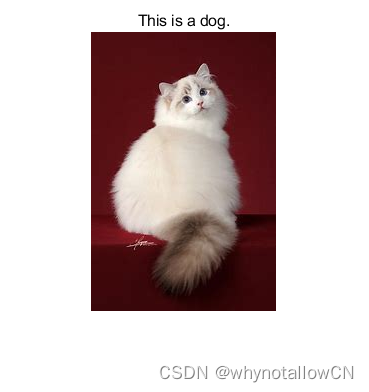
可以看到,在混淆矩阵中有接近一半的“猫”图片被识别为“狗”(3代表“猫”类,5代表“狗”类)。让神经网络识别在网上找的猫猫图片,同样会把猫识别成狗。说明网络对于猫和狗的细节部分还是没有把握住。因此可以考虑增加卷积层的数量,同时增加训练的迭代轮数,强化网络对猫和狗的不同特征的学习。代码如下:
%% 导入训练集数据和验证集数据
digitdatasetpath = fullfile(matlabroot,'cifar-10-batches-mat','train');
imds = imagedatastore(digitdatasetpath, ...
'includesubfolders',true,'labelsource','foldernames');
ytrain=imds.labels;
digittestdatasetpath = fullfile(matlabroot,'cifar-10-batches-mat','test');
test_imds = imagedatastore(digitdatasetpath, ...
'includesubfolders',true,'labelsource','foldernames');
% figure;
% perm = randperm(10000,20);
% fprint("b7744f63db749e48c05c06f7f3bd11d4")
% for i = 1:20
% subplot(4,5,i);
% imshow(imds.files{perm(i)});
% end
labelcount = counteachlabel(imds)
img = readimage(imds,1);
for i =1:50000
xtrain(:,:,:,i)=readimage(imds,i);
end
size(img)
%% 设置训练参数
imagesize = [32 32 3];
pixelrange = [-4 4];
imageaugmenter = imagedataaugmenter( ...
'randxreflection',true, ...
'randxtranslation',pixelrange, ...
'randytranslation',pixelrange);
augimdstrain = augmentedimagedatastore(imagesize,xtrain,ytrain, ...
'dataaugmentation',imageaugmenter, ...
'outputsizemode','randcrop');
%% 设置网络结构
layers = [
imageinputlayer([32 32 3])
convolution2dlayer(5,32,'padding','same')
batchnormalizationlayer
leakyrelulayer
maxpooling2dlayer(2,'stride',2)
convolution2dlayer(5,64,'padding','same')
batchnormalizationlayer
leakyrelulayer
maxpooling2dlayer(2,'stride',2)
convolution2dlayer(5,128,'padding','same')
batchnormalizationlayer
leakyrelulayer
maxpooling2dlayer(2,'stride',2)
convolution2dlayer(5,256,'padding','same')
batchnormalizationlayer
leakyrelulayer
maxpooling2dlayer(2,'stride',2)
convolution2dlayer(5,512,'padding','same')
batchnormalizationlayer
leakyrelulayer
fullyconnectedlayer(10)
softmaxlayer
classificationlayer];
%% 设置训练选项
options = trainingoptions('sgdm', ...
'initiallearnrate',0.01, ...
'maxepochs',50, ...
'shuffle','every-epoch', ...
'validationdata',test_imds, ...
'validationfrequency',200, ...
'verbose',false, ...
'plots','training-progress','executionenvironment','gpu');
net = trainnetwork(augimdstrain,layers,options);
%% 对有效识别图片进行分类并计算准确率
ypred = classify(net,test_imds);
yvalidation = test_imds.labels;
accuracy = sum(ypred == yvalidation)/numel(yvalidation)训练轮次调整为了50,并且网络又增加了2层卷积层,因此训练起来会更费时间,大概在50min左右。
改进网络的结果分析
改进以后的网络虽然训练时间更长了,但是识别结果也更准了,对“猫”类的识别正确率由原来的57.5%一下子提高到92.8%,整体识别率为95.69%,提高了很多。原本识别错误的猫猫图片现在也能识别正确了。

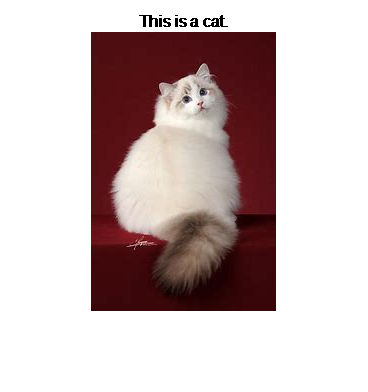
附
训练好的网络对图片进行分类的代码
myimage1=imread('图片位置');
figure,imshow(myimage1)
myimagex=imresize(myimage1,[32,32]);
ypred1=classify(net,myimagex);
str_ypred1=string(ypred1);
num_ypred=double(str_ypred1);
switch num_ypred
case 0
fprintf('this is a airplane.\n')
title('this is a airplane.')
case 1
fprintf('this is a automobile.\n')
title('this is a automobile.')
case 2
fprintf('this is a bird.\n')
title('this is a bird.')
case 3
fprintf('this is a cat.\n')
title('this is a cat.')
case 4
fprintf('this is a deer.\n')
title('this is a deer.')
case 5
fprintf('this is a dog.\n')
title('this is a dog.')
case 6
fprintf('this is a frog.\n')
title('this is a frog.')
case 7
fprintf('this is a horse.\n')
title('this is a horse.')
case 8
fprintf('this is a ship.\n')
title('this is a ship.')
case 9
fprintf('this is a truck.\n')
title('this is a truck.')
end绘制混淆矩阵图的代码这里就不放啦,有需要可以私信我。

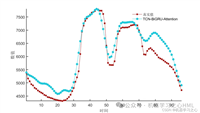

发表评论